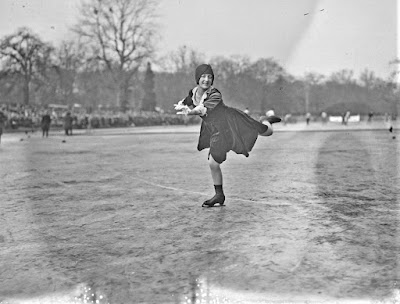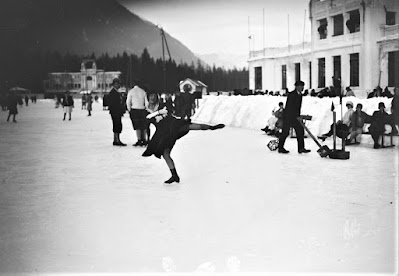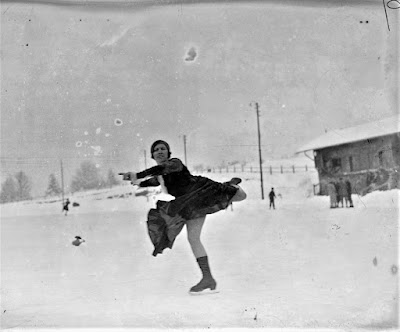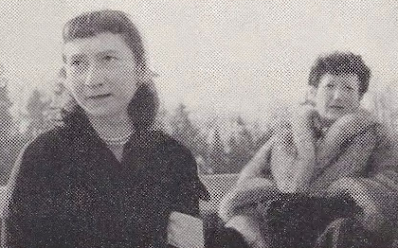It's the ghost wonderful time of the year and if you're a loyal Skate Guard reader you know what that means... it is time for The Annual Skate Guard Hallowe'en Spooktacular! This year, we're going all the way back to 1905 to meet a phantom skater with a message of murder in a chilling tale by British author Norman Blunto. Dim the lights, light a candle and prepare to be spooked.
THE PHANTOM SKATER
It was mid-winter not only in name but reality. It was not the best kind of weather to choose for travelling, but a pressing invitation from my cousin, Ralph Conroyd, made me forget the cold. I had never met this particular cousin, and was anxious to make his acquaintance. I was surprised to learn he reciprocated tho desire, seeing that I stood between him and the heirdom to considerable wealth.
It was a curious family arrangement; My old uncle, John Conroyd, had made it known that I and two other favourite nephews would in turn, become his heirs. He who ranked foremost in my eccentric relative's heart was not destined to, inherit, having been drowned two winters before when skating. His death was a great shock to my uncle, who nevertheless assured me that I was to fill the favourite's place, though Ralph, the dead man's brother, was my senior; by some fifteen years.
Ralph, however, accepted the arrangement with good humour, and had thereby won my admiration, and the esteem of his friends.
He greeted me with evident pleasure, and I soon discovered him to be an excellent host and most agreeable companion. On the evening of my arrival there was to be a dinner party in my honour, and wishing to be downstairs before the guests arrived, I dressed early.
There was no one about when I descended to the hall, and being somewhat uncertain of my whereabouts, I pushed open the first door I came to, which happened to be ajar. There was a bright fire burning on the hearth, but otherwise the room was not lit up. By the look of it I concluded it was my cousin's special sanctum. All at once I caught sight of him, as I thought - sitting on one side of the hearth - half in shadow, half in firelight.
"Ralph, you are not dressed - you will be late!" I said.
The next moment I saw I had made a mistake. The man was not my cousin, but so like there was excuse for my error. On looking closer, I observed that he was taller than Ralph, and also that he was clean shaven. It was a singularly handsome face, but too melancholy. Apparently he had not heard either my entry or exclamation, for he continued staring into the fire quite oblivious of my presence. Feeling I was in some way an intruder I was on the point of beating a retreat, when I felt a hand on my shoulder.
"Hullo, Jim - what's up? You've been standing there staring at nothing for a full two minutes."
It was my cousin who spoke, and with a cheery laugh he drew a chair up to the fire. "Come along, old fellow, warm yourself - before the people arrive. This is my den - a favourite corner in this ramshackle old place. Somehow, when a man's not married he gives his superfluous affection to queer things, like what you see around you -pipes, guns, fishing tackle, etc."
I was only half listening, for my eyes were still riveted on tho stranger on the other side of the fire. My astonishment suddenly changed to consternation, for I saw my cousin preparing to occupy the very chair the stranger occupied.
"Ralph, what are you doing-don't you see him?" I blurted out. Then all at once I felt very foolish.
"My dear Jim, what the dickens is wrong with you? Come, draw up that chair, and-"
I interrupted him with an exclamation that, was almost a shout, for he had seated himself deliberately on the stranger. I waited for some sound of discomfiture. There was none. I stared until my eyes ached. The man had gone. Then I sank into the chair at hand, feeling all the time my cousin was looking at me with suspicion and perplexity.
"You look us if you'd seen a spook or something," he said presently.
"I have," I replied.
"Jim, are you mad?"
"Mad or sane, I saw you sit on a man not two minutes ago, and he said nothing."
"I sat on a man! Great heavens! it's worse than I thought."
"Oh, you can laugh," I said quietly; "but he was certainly In that chair."
"Someone in my chair - where-where?"
"He was there, but he must have slipped from under you."
"What was he like, this gentleman of your imagination?"
I was somewhat nettled at his continued scepticism, and replied with due firmness:
"He was like you; in fact, before you entered I took him to be you. Afterwards I noticed he was clean-shaven and taller. He wore light tweeds and gaiters."
My cousin roe and fetched a photograph. "Was he anything like this?" he asked.
"Yes; that was the man," I replied feeling rather excited.
"Then you have seen my brother's ghost," he said, and I noticed he now looked perturbed. At that moment the first guests were announced and my cousin hurried away, leaving me to follow. The dinner was a merry one, and I thought no more of tho strange apparition until some days later.
One evening, when the moon was bright and full, Ralph proposed that we should go down to tho lake and have a skate before dinner. Being a keen lover of this exercise, I willingly assented. The ice was in splendid condition -smooth as glass, and dark with mysterious shadows below the surface. The air was still and frosty, and as we were both experienced skaters, the time passed all too quickly.
"One more turn - we won't bother to change tonight - come let us go together," said my cousin as the dinner going resounded through the still night air. We crossed hands and struck out. Twice we skated round tho lake; then I observed we wore heading for a small island which lay in a side channel which I had not noticed. Here the ice swayed under our weight, and weird small sounds rose up as we glided on, and the island threw out fantastic shadows.
"Look a bit gloomy - the moon doesn't seem to shine here," I said. Then, as my uncle made no answer, I suggested turning back, feeling there was an uncertainty about the condition of the ice, which, together with the semi-darkness, destroyed the pleasure I had hitherto enjoyed.
"It is safe enough. I know every inch of it," replied my cousin. Then I gripped his hand until he winced, for as we neared the Island I saw something come towards us from out of the black shadows. My heart beat to suffocation at the sight of this thing, until I recognised in it the figure of a man. Like ourselves, he appeared to be skating, but he never moved away from the shadows round about the island. A sudden premonition of an unknown danger forced me to speak.
"Ralph - he is there - go no further - it is a warning," I stammered, my teeth chattering, but not with cold.
"There is no one one," was the curt answer. "Come on, don't be a fool."
"I tell you I see him - your brother. He is skating alone there in the shadow -and see- he beckons us away. In my excitement I wrenched myself free, and by digging my skates into the ice I just managed to save myself from being carried into the very arms of the phantom man. I looked to see Ralph go blindly forward in his ignorance and obstinacy, but to my surprise he was skating away in the opposite direction, nor did he make any effort to rejoin
me.
Tho next day he left me to drive into a neighbouring town, and hinted that business might keep him there overnight.
After lunch, I went down to the lake. Dusk was deepening into darkness when at last I sat down on the bank to take off my skates. I do not know what made me look up, but as I looked, I saw a softly moving figure on the far side of the lake.
I held my breath as he passed so silently and swiftly over the ice, passing even by the spot where I sat. As he went a breath of chill air fanned me, colder than the night - colder than anything I had ever known.
The skates shone bright in the moonlight, but they made no sound, though I could see they touched the ice. It was horribly weird. Like a shadow he passed on to the shadows beyond appearing again in the moonlight on the far side.
"His reason - there must be a reason!" I muttered
And then quite suddenly my terror left me and I was filled with a desire to help this lone spirit, if help he needed.
I readjusted my skates, and struck out in the direction I had watched him go. I came close up to him. A great courage came to me then, and I spoke to him.
"Tell me what you want - I will do what I can," I whispered gently.
He seemed to smile a little, as if relieved of some anxiety, but he did not speak. I suppose he could not. We skated on side by side - his skates making no sound on the polished surface. When he came to the end of the lake, I looked to see him continue the old circular movement, but he passed straight on, vanishing like mist into the snowy landscape. I was disappointed, but still hoped I might solve the mystery of his strange comings. So strong was my hope that, instead of returning home to the house, I took up my position in another part of the lake in view of the island. I had not long to wait. A wave of chill air - and the phantom skater passed close. Then, to my amazement, I saw there were two figures, and one resembled my cousin Ralph. They glided by me hand in hand, just as I and Ralph had done some days earlier. On they went, until they came near the island. Here they fell apart; he who was like Ralph drew behind the other, then came close up to him. With a quick, strong push he sent his companion forward; then, wheeling round, vanished. Where the other shadow was the ice seemed to part asunder, and he too disappeared, but beneath, into tho dark waters.
I glanced round nervously, remembering how my cousin had tried to lure me on to the island. My brain reeled with misgivings and horrible doubts. Had my young cousin's death been an accident? Yet how could I accuse any man of a heinous crime on the evidence of a vision, which all tho world would discredit. I determined to put my suspicions to the test before accusing Ralph Conroyd of murder. My idea was not entirely unique; I believe it had been used before, but it served Its purpose
"Ralph," I said one evening, when we were smoking together. "You may have heard I am a bit of an author. I want your assistance, for I am stuck fast in the middle of a story."
"I am no good at yarns."
"But you may be able to give me an idea."
"What's the story?".
"There were three brothers," I began.
"Well, go on."
"By a strange whim, the father of those three made the youngest his heir. If by chance he died the second was was to inherit, and lastly the oldest. It was rough on this one, but he did not seem to care, and everyone admired his generosity of spirit. One day tho youngest brother met with a shooting accident. He was found dead -and-"
"Stop! What are you driving at?"
"It is merely a story. I know it resembles in some ways our own case, but fiction is always drawn from fact. As I was saying, the heir was dead. Everyone thought it was an accident, only the oldest brother, he who had been robbed of his birthright knew tho secret of his brother's death."
"You make him out a murderer?"
I nodded, and went on with my story.
"No one else knew, only the man himself. After a lapse of years, he conceived the mad idea of ridding himself of the other one who stood between him and wealth - but this one begins to suspect."
"Go on."
He was staring into the fire, and I saw guilt written in his eyes as clear as the flames which shot up the wide chimney. I noticed, too, that his pipe had gone out.
"That's the difficulty - I can get no further. How would you end the story?"
At my question he started, and then with a hollow laugh turned and looked me in the face.
"I should advise brother number two to go away and keep a silent tongue for fear the murderous instincts in brother number one should again assert themselves."
Was it a threat? But I was not afraid.
"The whole story is an improbable one - so the end may as well be in keeping- suppose we-"
"The story is not improbable - it is true," I said quickly, leaning forward to catch his glance, "and somehow I should advise the man who knew to leave the country, so that the man who suspects might learn to forget and keep silence. For the sake of the old man ho might be willing to do this - and because the other one was his brother."
Ralph Conroyd had risen and was now pacing the room.
"Perhaps that ending is more to the point," he muttered, "for the man who knew to go away from the man who fancied ho knew."
"Not fancied, for he saw the deed done."
I, too, had risen and was now facing him.
"Saw it done - you!" he gasped, "but no one was there - no one," he recollected himself, but not in time.
"You will leave the country?" I asked. At that moment I pitied him.
"Yes. I will go."
He kept his word. That very night, he disappeared, nor was he ever seen again in England. With him vanished forever the phantom skater.
Skate Guard is a blog dedicated to preserving the rich, colourful and fascinating history of figure skating. Over ten years, the blog has featured over a thousand free articles covering all aspects of the sport's history, as well as four compelling in-depth features. To read the latest articles, follow the blog on Facebook, Twitter, Pinterest and YouTube. If you enjoy Skate Guard, please show your support for this archive by ordering a copy of figure skating reference books "The Almanac of Canadian Figure Skating", "Technical Merit: A History of Figure Skating Jumps" and "A Bibliography of Figure Skating": https://skateguard1.blogspot.com/p/buy-book.html.







































